Abstract
Background
Circular RNAs represent a new class of noncoding RNAs involved in the development of cancer. However, little is known about their role in non-small cell lung cancer (NSCLC).
Methods
We examined hsa_circ_0003998 levels in 60 NSCLC tissues by quantitative real-time polymerase chain reaction and analyzed the clinicopathologic significance of hsa_circ_0003998 expression. The effect of small interfering RNA-mediated hsa_circ_0003998 knockdown on proliferation and invasion was analyzed in A549 and H1299 cells in vitro. Moreover, the target genes of hsa_circ_0003998 were further explored by bioinformatic analysis, dual luciferase reporter assays, and rescue experiments.
Results
Hsa_circ_0003998 upregulation was associated with larger tumor size and lymph node metastasis and also correlated with shorter overall survival of NSCLC patients. Functional experiments showed knockdown of hsa_circ_0003998 restrained cell proliferation and invasion in NSCLC cells. In particular, hsa_circ_0003998 upregulated the expression of miR-326 target gene Notch1 through sponging miR-326. Furthermore, the tumor-inhibiting effect of hsa_circ_0003998 silencing was blocked by miR-326 inhibitor.
Conclusion
hsa_circ_0003998/miR-326/Notch1 pathway regulates the progression of NSCLC.
Introduction
Lung cancer has the highest mortality rate among malignant tumors, and ~85% of lung cancers are non-small cell lung cancers (NSCLCs).Citation1,Citation2 Despite advances in treatment strategies, including surgery, radiation therapy, chemotherapy, targeted therapy, and immunotherapy, the prognosis of these patients remains poor.Citation3,Citation4 Therefore, the mechanism of lung cancer must be explored to identify potential biomarkers and therapeutic targets.Citation5
Circular RNAs (circRNAs) represent a novel class of noncoding RNAs formed by a covalently closed loop.Citation6,Citation7 Some studies revealed differential expression of circRNAs in gastric cancer, colorectal cancer, and esophageal squamous cancer, and these deregulated circRNAs have been suggested to play an important role in the regulation of cancer initiation and progression.Citation8–Citation10 However, the roles of circRNAs in NSCLC remain largely unknown.
Hsa_circ_0003998 is a circRNA that is 304 nt in spliced sequence length, and its gene is located at chr20:47570092–47580435. Based on CircBase database (http://circbase.org/) information, we examined the expression of hsa_circ_0003998 in NSCLC cells. Additionally, we further explored the biological function and mechanism of hsa_circ_0003998. Our data indicate that hsa_circ_0003998 exerts oncogenic functions in NSCLC.
Materials and methods
Tissue collection and cell culture
Sixty NSCLC and paired adjacent nontumorous tissue samples were obtained from patients during operation. Detailed clinical information is summarized in and this study was approved by the Ethics Committee of Yinzhou People’s Hospital (Ningbo, China). Written informed consent was obtained from every patient. All tissue specimens were stored at −80°C until use. The NSCLC cell lines H1299, H460, Calu1, and A549, and one cultured lung epithelial cell BEAS-2B were purchased from American Type Culture Collection and cultured in DMEM (GIBCO BRL, Grand Island, NY, USA) containing 10% fetal bovine serum, 100 U/mL penicillin, and 100 g/mL streptomycin at 37°C in 5% CO2 and 95% air.
Transient transfection
For the transfection of small interfering RNAs (siRNAs), A549 and H1299 cells (2×105) were seeded in 6- or 96-well plates. The following day, cells were transfected with 100 nM of siRNA using Lipofectamine 2000 Reagent (Invitrogen, Carlsband, CA, USA). The sequence of siRNA targeting hsa_circ_0003998 was as follows: 5′-UUAAAGUUGCAGGAGGCCAGA-3′.
RNA isolation
Total RNA was isolated from tissues or cells 48 hours after transfection using a TRIzol kit (Invitrogen) in accordance with the manufacturer’s instructions. Then chloroform was added to separate organic phase from inorganic phase. Isopropanol was used for the precipitation of total RNA. RNA concentration was measured using NanoDrop ND-2000 (Thermo Fisher Scientific, Wilmington, DE, USA). Total RNA (2 µg) was reverse transcribed to complementary DNA using random primers under standard conditions with the PrimeScript RT Reagent Kit (TaKaRa, Dalian, China).
Quantitative real-time PCR
Quantitative real-time polymerase chain reaction (qRT-PCR) was performed using TransStart Tip Green qPCRSuperMix (Transgen Biotech, Beijing, China) on the ABI 7500 system (Applied Biosystems, Carlsbad, CA, USA) following the manufacturer’s instructions. Glyceraldehyde-3-phosphate dehydrogenase mRNA was used to normalize the levels of circRNA and Notch1. U6 small nuclear RNA was used as an endogenous control for miR-326. All the values were standardized with 2−ΔΔCT method. The primers used were hsa_circ_0003998 forward, 5′-AAA GAG GCT CAT CAC TGT CAG G-3′, reverse, 5′-GGA CTG GGG TTT TGA CTG GAT-3′; Notch1 forward, 5′-GAG GCG TGG CAG ACT ATG C-3′, reverse, 5′-CTT GTA CTC CGT CAG CGT GA-3′; miR-326 forward, CCT CTG GGC CCT TCC TCC AG, reverse, 5′-GCG AGC ACA GAA TTA ATA CGA C-3′.
Cell proliferation and colony formation assays
Cell proliferation was quantified using the Cell Counting Kit-8 (CCK-8, Dojindo, Japan) according to the manufacturer’s protocol. For colony formation assays, 24 hours after transfection, approximately 500 cells were plated in each well of six-well plates and cultured routinely for 2 weeks. Then, the colonies were fixed with methanol and stained with 0.5% crystal violet. Three independent experiments were performed for each assay.
Luciferase reporter assay
The wild-type and mutant hsa_circ_0003998 were cloned into pGL3-control vector. 5×104 lung cancer cells were seeded in 24-well plates. Forty-eight hours after cotransfection with corresponding plasmids and miR-326/negative control (NC), luciferase activity was measured using dual-luciferase reporter assay system (Promega, Madison, WI, USA) according to the manufacturer’s instructions. Relative luciferase activity was normalized to the Renilla luciferase internal control.
Invasion assays
Invasion assays were performed using Matrigel invasion chambers (BD Bioscience, Billerica, MA, USA). 1×105 cells suspended in serum-free DMEM were seeded into the upper chamber, while medium containing 10% fetal bovine serum was placed into the lower chamber. After 24 hours of incubation, cells remaining on the upper membrane were discarded and the cells adherent to underside of the membrane were fixed and stained with 0.5% crystal violet. Ten random fields were counted under a microscope in the high-power field.
Western blot
Cancer cells were lysed using RIPA buffer, and 8% SDS-PAGE was used to separate protein extracts. Then immunodetection was performed using standard techniques. Antibodies against Notch1 and β-actin were purchased from Santa Cruz Biotechnology, Inc. (Santa Cruz, CA, USA). HRP-conjugated secondary antibodies were also used.
Statistical analysis
Statistical analysis was performed using SPSS 16.0 software (SPSS Inc.). Data were presented as the mean ± SD. Overall survival rates were calculated by Kaplan–Meier analysis. The relationship between hsa_circ_0003998 and miR-326/Notch1 expression was tested with two-tailed Pearson’s correlation. Differences were considered significant when P<0.05.
Results
Hsa_circ_0003998 expression was increased in NSCLC cell lines and tissues
To verify the bioinformatic analysis results for hsa_circ_0003998, we used qRT-PCR to measure hsa_circ_0003998 expression levels in NSCLC cell lines and tissues. Our results showed that hsa_circ_0003998 expression was increased in four lung cancer cell lines (A549, H1299, H460, and Calu1) compared with that in lung epithelial BEAS-2B cells (). We next assessed hsa_circ_0003998 expression in NSCLC tissues. As shown in , hsa_circ_0003998 was significantly upregulated in NSCLC tissues compared with normal tissue. Examination of the correlation between hsa_circ_0003998 expression and clinical pathological features showed that hsa_circ_0003998 upregulation was correlated with larger tumor size and lymph-node metastasis (). Furthermore, Kaplan–Meier survival curves showed that patients with higher hsa_circ_0003998 expression in NSCLC had poorer prognoses ().
Figure 1 Hsa_circ_0003998 expression was upregulated in NSCLC cells and tissues.
Abbreviation: NSCLC, non-small cell lung cancer.
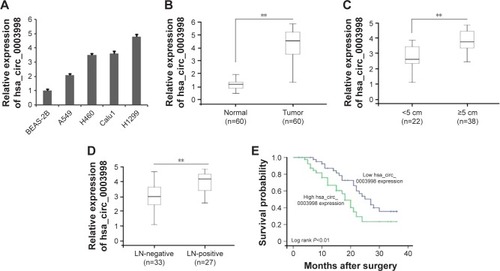
Hsa_circ_0003998 knockdown inhibited NSCLC cell proliferation and invasion
To confirm the functional role of hsa_circ_0003998 in NSCLC, siRNA for hsa_circ_0003998 was transfected into A549 and H1299 cells. A satisfactory transfection efficiency was obtained at 48 hours posttransfection (). CCK-8 and colony formation assays revealed that hsa_circ_0003998 knockdown dramatically reduced the proliferative capacities of A549 and H1299 cells (). In addition, invasion assays indicated that hsa_circ_0003998 knockdown significantly reduced the invasive capacity of A549 and H1299 cells ().
Figure 2 Hsa_circ_0003998 knockdown suppressed NSCLC cell proliferation and invasion in vitro.
Abbreviations: NSCLC, non-small cell lung cancer; siRNA, small interfering RNA; NC, normal control.
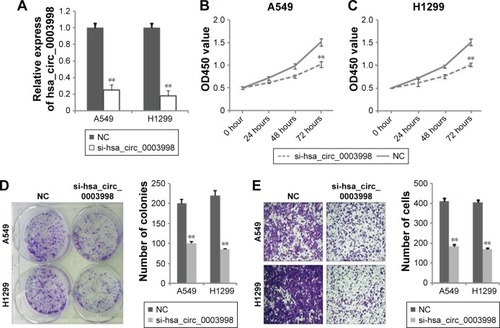
Hsa_circ_0003998 sponged miR-326
Because circRNAs function mainly as miRNA sponges to regulate gene expression by binding functional miRNAs, we next examined the potential miRNAs associated with hsa_circ_0003998. By using bioinformatics program (Circular RNA Interactome, https://circinteractome.nia.nih.gov/index.html), we selected miR-326 as a possible target of hsa_circ_0003998 (). As illustrated in , miR-326 was dramatically downregulated in NSCLC tissues, and a significant negative correlation was also found between hsa_circ_0003998 and miR-326 expressions. After knockdown of hsa_circ_0003998, miR-326 expression was increased compared with control (). To further validate the regulatory relationship between hsa_circ_0003998 and miR-326, we performed dual-luciferase reporter assays. As shown in , miR-326 mimics reduced the luciferase activity of wild-type hsa_circ_0003998 reporter vector but not that of mutant reporter vector. These data suggest that hsa_circ_0003998 binds directly to miR-326.
Figure 3 The interaction of hsa_circ_0003998 and miR-326.
Abbreviations: NSCLC, non-small cell lung cancer; qRT-PCR, quantitative real-time polymerase chain reaction.

An miR-326 inhibitor rescued the function of hsa_circ_0003998 knockdown
As miR-326 is downregulated in NSCLC (), we next performed rescue experiments to verify whether miR-326 is involved in hsa_circ_0003998-induced NSCLC cell proliferation and invasion. There was a significant decrease in miR-326 expression by the miR-326 inhibitor, compared with that in si-hsa_circ_0003998-transfected H1299 cells (). CCK-8, colony formation, and invasion assays showed that the miR-326 inhibitor rescued the suppressive roles of si-hsa_circ_0003998 ().
Figure 4 miR-326 inhibitor rescued the function of hsa_circ_0003998 knockdown in H1299 cells.
Abbreviations: NSCLC, non-small cell lung cancer; RT-PCR, real-time polymerase chain reaction; NC, normal control.
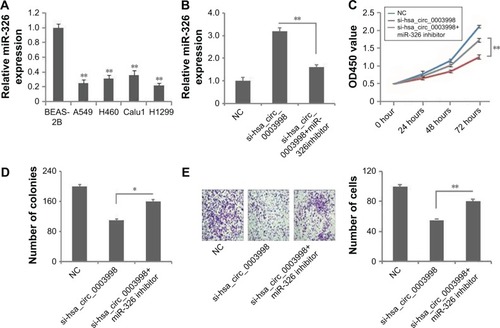
Hsa_circ_0003998 modulated the expression of the endogenous miR-326 target Notch1
We then detected one of the target genes of miR-326, Notch1,Citation11 which is expressed at significantly higher levels in the NSCLC cell lines than in BEAS-2B cells (). As shown in , silencing of hsa_circ_0003998 significantly reduced the mRNA and protein expression levels of Notch1, while the miR-326 inhibitor increased the mRNA and protein expression levels of Notch1 in H1299 cells. Furthermore, the expressions of miR-326, hsa_circ_0003998, and Notch1 were examined in 30 tumor specimens used above. As shown in , Notch1 mRNA expression was negatively correlated with miR-326 expression. In contrast, Notch1 expression was positively correlated with hsa_circ_0003998 expression (). These results suggest that hsa_circ_0003998 may exert oncogenic functions by modulating miR-326/Notch1.
Figure 5 Hsa_circ_0003998 positively regulated the miR-326 target gene Notch1.
Abbreviation: NSCLC, non-small cell lung cancer; NC, normal control.
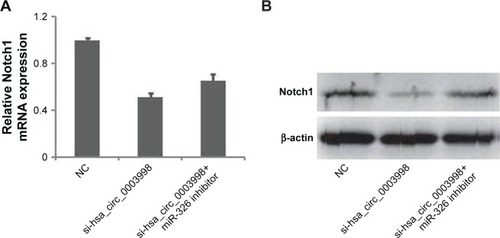
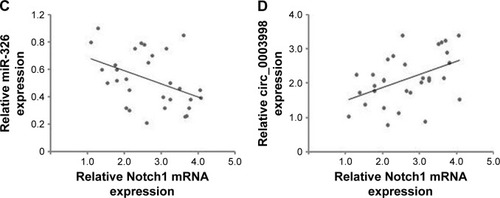
Discussion
CircRNAs are a novel class of extensive endogenous RNAs. The two most important properties of circRNAs are that they are highly conserved and very stable;Citation12,Citation13 these advantages provide circRNAs with the potential to be ideal biomarkers for diagnosis of disease, including cancers.Citation14–Citation16 In this report, we demonstrated that a high expression level of hsa_circ_0003998 in NSCLC patients was associated with larger tumor size and lymph-node metastasis. Importantly, high hsa_circ_0003998 levels had a significantly lower survival rate than those with low expression levels. These results suggest that hsa_circ_0003998 may be used as a potential predictor of prognosis in NSCLC.
The functions of circRNAs in cancer progression have not been elucidated very clearly. The most reported function pattern for circRNAs is acting as miRNA sponges; this “sponge” characteristic is similar to that of long noncoding RNAs (lncRNAs), which suggests that circRNAs exert their regulatory function by binding miRNAs. For example, Cdr1 as, also known as CiRS-7, was shown to harbor 76 miR-7 binding sites.Citation17 The circRNA MTO1 suppresses hepatocellular carcinoma progression by acting as a sponge of miR-9.Citation18 In lung adenocarcinoma, hsa_circ_0013958 was identified as a sponge of miR-134, and hsa_circ_0013958 levels were associated with tumor node metastasis stage.Citation19 Here, we employed bioinformatics analysis and provide evidence that the hsa_circ_0003998 plays an oncogenic role in lung pathogenesis via the modulation of miR-326.
MiR-326 is downregulated in various types of cancers including colorectal cancer,Citation20 lung cancer,Citation21 and glioma.Citation22 Our previous studies showed that miR-326 involved in chemotherapy resistance in lung cancer through modulating the expression of specificity protein 1.Citation23 In this study, we demonstrated miR-326/Notch1 axis mediated the effect of hsa_circ_0003998 on proliferation and invasion. Notch1 has been regarded as a candidate molecule responsible for the development of lung cancer.Citation24–Citation26 Therefore, hsa_circ_0003998/miR-326/Notch1 is a key pathway in the development of NSCLC.
In summary, our results show that hsa_circ_0003998 was upregulated in NSCLC and this elevated hsa_circ_0003998 expression was associated with aggressive clinicopathological features. Functional experiments showed hsa_circ_0003998 acted as an oncogene in NSCLC via modulating miR-326/Notch1. Our data suggest that hsa_circ_0003998 may have considerable potential as a prognostic predictor and therapeutic target in NSCLC.
Acknowledgments
This work was supported by Zhejiang Provincial Medicine and Health Science Research Foundation of China (2018KY749) and Zhejiang Provincial Traditional Chinese Medicine Foundation of China (Grant No 2017ZA128).
Supplementary materials
Figure S1 Relative expression levels of Notch1 mRNA were detected in four NSCLC cells and one cultured human lung epithelial cells via qRT-PCR.
Abbreviations: NSCLC, non-small cell lung cancer; qRT-PCR, quantitative real-time polymerase chain reaction.
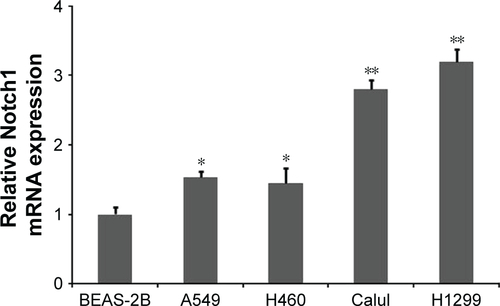
Table S1 Association between hsa_circ_0003998 expression and clinicopathological characteristics
Disclosure
The authors report no conflicts of interest in this work.
References
- SiegelRLMillerKDJemalACancer statistics, 2015CA Cancer J Clin201565152925559415
- SpiraAEttingerDSMultidisciplinary management of lung cancerN Engl J Med2004350437939214736930
- WangEHRutterCECorsoCDPatients selected for definitive concurrent chemoradiation at high-volume facilities achieve improved survival in Stage III non-small-cell lung cancerJ Thorac Oncol201510693794325738221
- ShroffGSde GrootPMPapadimitrakopoulouVATruongMTCarterBWTargeted therapy and immunotherapy in the treatment of non-small cell lung cancerRadiol Clin North Am201856348549529622080
- SchneiderMAGranzowMWarthAGlycodelin: a new biomarker with immunomodulatory functions in non-small cell lung cancerClin Cancer Res201521153529354025901080
- ChenLLYangLRegulation of circRNA biogenesisRNA Biol201512438138825746834
- HentzeMWPreissTCircular RNAs: splicing’s enigma variationsEMBO J201332792392523463100
- LiPChenSChenHUsing circular RNA as a novel type of biomarker in the screening of gastric cancerClin Chim Acta201544413213625689795
- HuangGZhuHShiYWuWCaiHChenXcir-ITCH plays an inhibitory role in colorectal cancer by regulating the Wnt/β-catenin pathwayPLoS One2015106e013122526110611
- LiFZhangLLiWCircular RNA ITCH has inhibitory effect on ESCC by suppressing the Wnt/β-catenin pathwayOncotarget2015686001601325749389
- KefasBComeauLFloydDHThe neuronal microRNA miR-326 acts in a feedback loop with notch and has therapeutic potential against brain tumorsJ Neurosci20092948151611516819955368
- JeckWRSorrentinoJAWangKCircular RNAs are abundant, conserved, and associated with ALU repeatsRNA201319214115723249747
- MemczakSPapavasileiouPPetersORajewskyNIdentification and characterization of circular RNAs as a new class of putative biomarkers in human bloodPLoS One20151010e014121426485708
- ZhaoZJShenJCircular RNA participates in the carcinogenesis and the malignant behavior of cancerRNA Biol201714551452126649774
- QinMLiuGHuoXHsa_circ_0001649: a circular RNA and potential novel biomarker for hepatocellular carcinomaCancer Biomark201616116116926600397
- QuSYangXLiXCircular RNA: A new star of noncoding RNAsCancer Lett2015365214114826052092
- HansenTBJensenTIClausenBHNatural RNA circles function as efficient microRNA spongesNature2013495744138438823446346
- HanDLiJWangHCircular RNA circMTO1 acts as the sponge of microRNA-9 to suppress hepatocellular carcinoma progressionHepatology20176641151116428520103
- ZhuXWangXWeiShsa_circ_0013958: a circular RNA and potential novel biomarker for lung adenocarcinomaFEBS J2017284142170218228685964
- WuLHuiHWangLJWangHLiuQFHanSXMicroRNA-326 functions as a tumor suppressor in colorectal cancer by targeting the nin one binding proteinOncol Rep20153352309231825760058
- CaiMWangZZhangJAdam17, a target of Mir-326, promotes Emt-induced cells invasion in lung adenocarcinomaCell Physiol Biochem20153631175118526111641
- NawazZPatilVPaulYPI3 kinase pathway regulated miRNome in glioblastoma: identification of miR-326 as a tumour suppressor miRNAMol Cancer20161517427871300
- LiJLiSChenZmiR-326 reverses chemoresistance in human lung adenocarcinoma cells by targeting specificity protein 1Tumour Biol20163710132871329427460077
- MariscalJAlonso-NoceloMMuinelo-RomayLMolecular profiling of circulating tumour cells identifies Notch1 as a principal regulator in advanced non-small cell lung cancerSci Rep201663782027901069
- ChenCYChenYYHsiehMSExpression of Notch gene and its impact on survival of patients with resectable non-small cell lung cancerJ Cancer2017871292130028607605
- ZhangYXuWGuoHNOTCH1 signaling regulates self-renewal and platinum chemoresistance of cancer stem-like cells in human non-small cell lung cancerCancer Res201777113082309128416482
